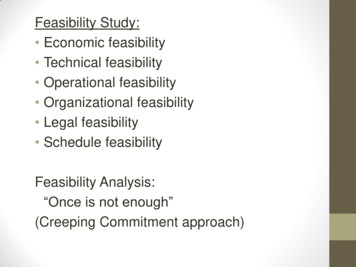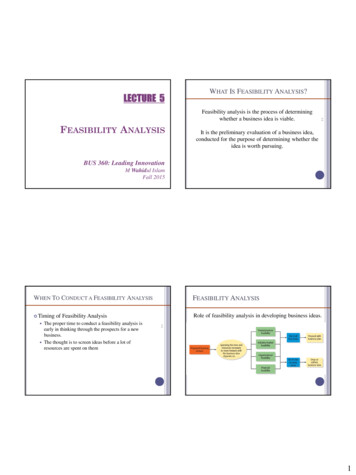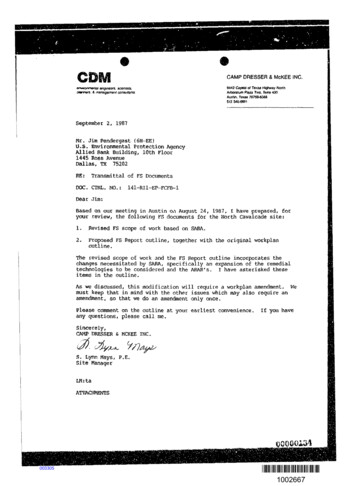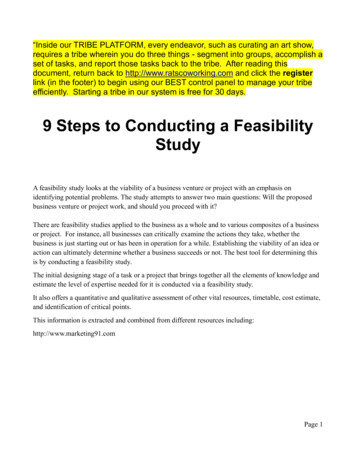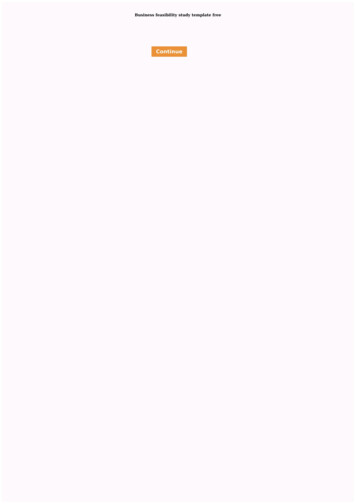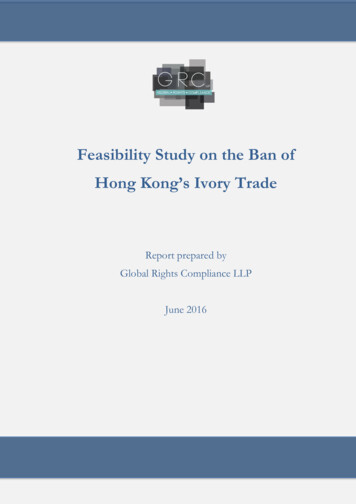
Transcription
Feasibility Study on the Ban ofHong Kong’s Ivory TradeReport prepared byGlobal Rights Compliance LLPJune 2016
This report was prepared by Global Rights Compliance, and commissioned by WorldWide Fund for Nature Hong Kong (WWF-Hong Kong).Global Rights Compliance is registered as a limited liability partnership through theCompanies House in the United Kingdom, Partnership No. OC388087. Its registeredaddress is Endeavour House, 78 Stafford Road, Wallington, Surrey, United KingdomSM6 9AY.Lead Authors: Scott Martin, Managing Partner, Global Rights Compliance LLP; Attorney (USA;Washington DC) Tim Parker, Consultant, Global Rights Compliance LLP; Barrister (Hong Kong)Contributing Authors: Richard Saines, Partner, Baker & McKenzie, Attorney (USA, Illinois) Marisa Martin, Associate, Baker & McKenzie, Attorney (USA, California &Illinois) Isabel Tam, Barrister (Hong Kong); Attorney (New York)Contributing Researchers: Mathew Crowe, Legal Consultant, Global Rights Compliance LLP; Barrister(England & Wales) Natacha Bracq, Legal Consultant, Global Rights Compliance LLP; Avocat(France, Paris bar) Y.J.M. Elouri, Legal Consultant, Global Rights Compliance LLP; LLB in law(England & Wales)Acknowledgements:
Gavin Edwards, Cheryl Lo, Ken Chan – WWF-Hong Kong Colman O Criodain, Elisabeth McLellan, Rob Parry-Jones – WWF-International Jan Vertefeuille – WWF-US Yannick Kuehl, Wilson Lau – TRAFFIC East Asia Yang Xu – WWF-China Janpai Ongsiriwittya – WWF-Thailand
Table of ContentsIntroduction . 6Executive Summary . 8Status Quo: the Present Regulatory Framework . 9A. The CITES Ordinance91. The General Ban 112. Exceptions to the General Ban12a)Pre-Convention Ivory12b)Licensed Possession 15c)Household/Personal Effectsd)Further Miscellaneous Exceptions 2119Discussion . 22A. Legal Measures Regulating the Ivory Trade1. Trade Bans and Restrictions in Other Jurisdictionsa)United Statesb)China34c)Japan38d)Thailand42222222B. Precedents of bans on other items in Hong Kong 451. Poultry / Pig Farming45a)Justifications49b)Compensation Scheme502. Trawling 54a)Justifications54b)Compensation Schemesc)Enforcement of the Trawling Ban 59d)Punishment 60553. Summary of Matters Raised in Precedents of Bans60C. Potential Obstacles to Ban on Ivory Trade which Factors in Legal, Policy, andCompensation Matters 63Page 4 of 123
1. Legal Issues63a)Article 105 of the Basic Law of the HKSAR63a)“Deprivation” of property 67b)Measures affecting property less than deprivations 81c)Application of BL105 to enhanced ivory measures 85d)Legal Texts of the World Trade Organizatione)Bilateral investment treaties 106100Summary of Conclusions . 110Recommendations and Timeline for Implementation . 110A. Recommendation 1: Administration should Announce its Intention to Outlaw theCommercial Ivory Trade.110B. Recommendation 3: Phase-out of Possession Licence Conditions PermittingCommercial Trade111C. Recommendation 4: Introduce Legislation Outlawing the Domestic Trade in Ivory111Page 5 of 123
Introduction11.Despite a global ban on international trade of elephant ivory under theConvention on International Trade in Endangered Species of Wild Fauna andFlora (‘CITES’) since 1989, more than 30,000 elephants are still killed eachyear for their tusks to satisfy the demand for ivory products. Demand isfocused heavily in Asia.2.CITES outlaws the international trade in ivory, but does not require Statesparties to ban purely domestic trade – although they remain free to do so, as amatter of best practice. Under Hong Kong law, any ivory removed from thewild before 1976 (i.e. pre-CITES ivory) can be freely traded, while ivorylawfully imported into Hong Kong between 1976 and 1990 (i.e. pre-ban ivory)may be traded within Hong Kong subject to the possession of a licence.There also exist exceptions for personal and household effects, scientific andeducational samples, and so forth.3.Unfortunately, there is clear evidence indicating that the system is beingabused. Graphic evidence of the illegal ivory trade in Hong Kong wasdocumented recently by independent investigators, who published undercoverfootage demonstrating that Hong Kong ivory traders can easily engage in theillegal sale of ivory trade.2 Persons identified by investigators as licenced ivorytraders can be seen candidly admitting that they can supplement their stockswith tusks of recently killed elephants. One ivory trader in Hong Kong franklyadmitted that he could deal in illegally imported ivory removed from the wildafter the ban in 1990. Proof of illegal trade is further corroborated by the factthat the diminution of ivory stocks reported to the Agriculture, Fisheries andConservation Department (“AFCD”) appears to be inconsistent with the1The Introduction is based on various reports from World Wildlife Fund for Nature Hong Kong.See WWF’s 2015 report: “The Hard Truth: a report on how Hong Kong's ivory trade is fueling the African elephantpoaching crisis”, available 16/files/original/wwf ivorytrade eng eversion.pdf?1442844784& ga 1.27258814.226526283.1462527543Page 6 of 123
large number of commercial ivory licence holders, their stocks, and theirbusinesses in high rent-locations in the city.4.The current Hong Kong regulatory scheme is not up to the task. While theapproach of the Hong Kong government to regulate the trade of theremaining legal stockpile through a system of licensing is pragmatic, it is clearthat the failure to effectively regulate the trade or completely ban the ivorytrade altogether has contributed to the illegal trading market, and in turn tothe poaching of more elephants in the wild. There is an overwhelming casefor change. The Government of the Hong Kong SAR agrees, and we notethat Chief Executive Leung Chun-ying has publicly committed to taking“appropriate measures, such as enacting legislation to further ban the import and export ofivory and phase out the local ivory trade” on January 13, 2016.35.In the following sections, this Report examines the route to accomplishing theGovernment’s goal. First, we analyse Hong Kong’s current legislativeframework in detail. The study then goes on to consider comparable measuresadopted in other states and jurisdictions that have instituted bans orsignificant restrictions on the trade of ivory. Particular attention is paid to theUnited States, where the most significant bans and considerable restrictionsare under way. The Report then goes on to consider other bans initiated bythe Hong Kong Government in response to environmental and healthconcerns, including the pig and poultry bans, as well as the ban on trawling.6.After these sections, the study then considers the relevant legal and policymatters, focusing in particular on whether a ban on the sale and purchase ofivory would give rise to an obligation to compensate traders for theirremaining legal commercial stock. The study concludes with a proposedaction plan for the Government in order to rapidly follow through on theircommitment to ban the local trade, and a suggested strategy and otherrecommendations to World Wide Fund for Nature Hong kong-ivory-trade/Page 7 of 123
Executive Summary7.A detailed action plan and timeline outlining the best way forward is set out atthe end of this study (see §290 et. seq.). In short, this study recommends theoutlawing the domestic ivory trade in Hong Kong and sets out a list ofspecific actions and measures that can be taken to facilitate the transition. Theimplementation of the ban could be achieved either through executive actionor by way of a legislative amendment – or a combination of both. Specificmeasures are proposed.8.The key measured recommended are:a.Executive action: Agriculture, Fisheries and Conservation Department(“AFCD”) to cease issuing Possession Licences4 which contain a termpermitting any sale or purchase of ivory. (This would outlaw the trade in“post-Convention, pre-ban ivory”, i.e. that imported into Hong Konglawfully between 1976 and 1990); andb.Legislative action: Legislation be introduced to outlaw the sale andpurchase of pre-Convention ivory (i.e. ivory removed from the wildbefore 1976).9.These measures should be subject to limited exemptions which, it isanticipated, are unlikely to significantly undermining the effectiveness of theproposed measures. The Administration should consider allowing thefollowing further exemptions:a.Personal possession of post-Convention, pre-ban ivory for any noncommercial purpose, including ivory which constituted traders’ legalstock prior to the trade ban but was thereafter kept for personalpossession;4Defined at §§28-38 below.Page 8 of 123
b.Dealings with ivory as part of legitimate law enforcement activities;c.Dealings with ivory that is part of a documented bona fide antique ofantiquity dated before 1940 – at least 50 years before the entry intoforce of the domestic ivory trade ban (including, if the Administrationdeems it expedient, subject to a licencing regime);d.Ivory sold for educational or scientific purposes by education orscientific institutions (subject to the possession of an appropriatelicence); ande.Ivory used for commercial purposes other than dealing, i.e. exhibitions.f.Other miscellaneous, Hong Kong-specific activities authorised underthe law.10. It is furthermore suggested that the intended implementation of the domesticivory trade ban could be announced in advance, specifying the date of futureimplementation, allowing time for ivory traders to liquidate their current ivorystocks. This report’s finding aligns in principle with Hong Kong government’sproposed ivory ban (see appendix I) which states that no compensation isneeded, as traders have had 26 years to get rid of their stocks. However thegovernment has proposed a longer timeframe of five years to implement aban. This is understandable, because if government moves more quickly thenthey may face opposition from legislators, whose support is vital in order tosecure the ban.Status Quo: the Present Regulatory FrameworkA.The CITES Ordinance11. The import, export, re-export, and possession of ivory in Hong Kong isregulated under the Protection of Endangered Species of Animals and PlantsPage 9 of 123
Ordinance (Cap. 586) (the “CITES Ordinance” or the “Ordinance”).5 Theprime purpose of the CITES Ordinance, as recited in section 1, is to giveeffect to the provisions of the Convention on International Trade inEndangered Species of Wild Fauna and Flora (“CITES”)6, which is in forcein relation to the HKSAR.12. The scheme of the Ordinance closely tracks CITES itself (although there arematerial differences). It imposes a tiered system of bans and regulations inrelation to specimens of the various endangered species protected underCITES. African and Asian Elephants are “Appendix I” species – i.e. the mostendangered species, therefore listed in Appendix I of CITES and, accordingly,also listed in the first column in Schedule 1 of the Ordinance. This is the moststringently regulated category. Asian elephants were listed on Appendix Iwhen CITES came into force on 1 July 1975; African elephants were initiallyan Appendix III species, but were upgraded to Appendix II in 1976 andfurther to Appendix I in 1989.713. According to Article II of CITES, entitled “Fundamental Principles”:“Appendix I shall include all species threatened with extinction which are or may be affectedby trade. Trade in specimens of these species must be subject to particularly strict regulation inorder not to endanger further their survival and must only be authorized in exceptionalcircumstances.”CITES has been implemented in Hong Kong since 1976 through the enactment of the Animals andPlants (Protection of Endangered Species) Ordinance, Cap. 187. It was repealed and replaced by theProtection of Endangered Species of Animals and Plants Ordinance, Cap. 586, in December 2006.56Adopted 3 March 1973, 993 United Nations Treaty Series 243 (as amended). Entry into force 1 July 1975.The amendment took effect from 20 January 1990. Note, however, that the United KingdomGovernment appended a reservation to this amendment in respect of Hong Kong. This postponed theeffect of the re-classification for as regards Hong Kong for a further 6 months (in addition to the usual 90day grace period), so that the re-classification did apply to Hong Kong until 20 July 1990. Furthermore,CITES allowed Botswana, Namibia, Zimbabwe and subsequently South Africa to transfer their elephantpopulations to Appendix II in 1997 and 2000.7Page 10 of 123
1.The General Ban14. Pursuant to sections 5-9 of the Ordinance, Appendix I species are subject to ageneral ban (although there are important exceptions, discussed below). Thesesections outlaw, respectively, the import (section 5), introduction from the sea(section 6), export (section 7), re-export (section 8) possession and control(section 9) in Hong Kong of all Appendix I species including ivory.15. Each of these provisions creates a criminal offence and stipulates the penaltyfor such unauthorised instances of import, introduction from the sea, export,re-export or possession and control of Appendix I species. The penaltiesunder each of sections 5 to 9 inclusive are six months’ imprisonment and afine. (The actual penalty meted out in any given case is likely to turn on anumber of factors including the quantity involved; whether the defendant hasoffended before; whether s/he pleads guilty; and a range of other relevantaggravating or mitigating circumstances). The seized specimens will, withoutfurther order, also be forfeited to the government.16. Section 10 then further mandates an enhanced penalty for any conductcontrary to these sections if it is proven to have been done for a “commercialpurpose”. The definition of “commercial purposes” is provided in section 2of the Ordinance as follows:“‘commercial purposes’ (商業目的) means—(a) a purpose relating to trade or business; or(b) a purpose of obtaining profit or other economic benefit (whether in cash or in kind)and directed towards sale, resale, exchange, provision of a service or other form ofeconomic use or benefit, whether direct or indirect”17. Thus although the Ordinance does not say so in terms, the sale and purchaseof Appendix I species such as ivory is in fact generally banned (subject to thespecific exceptions discussed below). The phrase “possess or have undercontrol” within section 9 is not expressly defined. However, read togetherPage 11 of 123
with section 10, it is plain that possession for a commercial purpose would ona proper interpretation include possession for, or in the course of, a sale.Where section 10 applies, the maximum penalty is increased to two years’imprisonment and a fine of HK 5,000,000.2.Exceptions to the General Ban18. As just mentioned, the general ban against the import, export and possession(etc.) of Appendix I species such as ivory is subject to a number ofexceptions. These need to be properly understood in order to test the efficacyof the present regime and analyse what solutions are necessary to fix theserious problems that have built up under the present system. The relevantexceptions are as follows:a)Pre-Convention Ivory19. The general ban outlined above does not apply to ‘pre-Convention ivory’,which is provided for in Part 4 of the CITES Ordinance (entitled“Circumstances in which dealings in Scheduled species without licence are permitted”).20. The relevant provisions are sections 17 and 20 of Part 4 of the CITESOrdinance. These create certain limited exemptions to the general ban uponproof that the specimens are “pre-Convention specimens”. 8 The studydescribes these as ‘limited’ exemptions because they apply only to import,possession or control of such “pre-Convention specimens”; they do not coverexport, re-export or introduction from the sea.21. These provisions reads as follows:Section 17:This exemption is based on Article VII(2) of CITES, while provides that: “Where a Management Authority ofthe State of export or re-export is satisfied that a specimen was acquired before the provisions of the present Conventionapplied to that specimen, the provisions of Articles III, IV and V shall not apply to that specimen where the ManagementAuthority issues a certificate to that effect.”8Page 12 of 123
“A person may import a specimen of a scheduled species if, upon the landing of the specimenin Hong Kong—(a) he produces, or causes to be produced, to an authorized officer a pre-Conventioncertificate, or a Convention certifying document containing the particulars required to bespecified in a pre-Convention certificate, in respect of the specimen;(b) an authorized officer has inspected the specimen to compare it with the particulars onthat pre-Convention certificate or Convention certifying document and is satisfied that theparticulars tally; and(c) where a Convention certifying document is produced under paragraph (a), that personsurrenders, or causes to be surrendered, to the authorized officer that document forretention and cancellation.”Section 20:“A person may have in his possession or under his control a specimen of an Appendix Ispecies or Appendix II species if he proves the following to the satisfaction of the Director—(a) that he possesses a pre-Convention certificate in respect of the specimen;(b) that the specimen was imported, or introduced from the sea, before 6 August 1976;or(c) if the specimen was imported, or introduced from the sea, on or after that date, theimport or introduction from the sea was not in contravention of any provision of therepealed Ordinance or this Ordinance, whichever was in force at that time.”22. Accordingly, notwithstanding the general ban, it is not an offence to importor be in possession or control of a specimen certified as pre-Conventionivory, or which can be shown to have been imported into Hong Kong before6 August 1976. The relevant offence provisions, namely section 5 (the importban) and section 9 (the possession and control ban), are expressly madesubject to sections 17 and 20 respectively.23. The procedure for certification as “pre-Convention specimen” is set out inPart 2 to Schedule 3 of the CITES Ordinance. The power to issuePage 13 of 123
certification vests in the Management Authority of each CITES party – inHong Kong’s case, the AFCD.24. A specimen may be certified as a “pre-Convention specimen” only if theapplicant for such certification can satisfy AFCD (or an overseas ManagementAuthority) that the specimen was “acquired” on a date before the provisionsof CITES applied to the species in question. The date of “acquisition” isascertained in accordance with section 6 of Schedule 3 to the CITESOrdinance,9 which provides:“6. For the purposes of determining whether a specimen was acquired before the provisions ofthe Convention applied to the specimen (“pre-Convention”)—(a) the date from which the provisions of the Convention apply to a specimen shall be thedate on which the species concerned was first included in the Appendices to theConvention; and(b) the date on which a specimen was acquired is—(i) the date on which the specimen was known to be removed from the wild;(ii) the date on which the specimen was known to be born in captivity or artificiallypropagated in a controlled environment; or(iii) if the date referred to in sub-subparagraph (i) or (ii) is unknown or cannot beproved, the earliest provable date on which it was first possessed by any person.”25. So, summarising: if the holder of a given specimen of ivory can demonstratethat it is pre-Convention ivory s/he may freely import it into Hong Kong, andwhen in Hong Kong, have it in his/her possession and under his/her controlwithout the need for any licence or other permission.26. It would appear to follow that certified pre-Convention ivory may, under thepresent regulatory framework, be imported for commercial purposes and mayThe definition of “acquired” provided in section 6 of Schedule 3 is based on the definition adopted bythe Conference of the Parties to CITES in Resolution 13.6 (revised) entitled: “Implementation of Article VII,paragraph 2, concerning ‘pre-Convention’ specimens”.9Page 14 of 123
be freely bought or sold in Hong Kong without the need for any licence. Thisis the case since the import, possession and control offences (in sections 5and 9 of the CITES Ordinance) simply do not apply at all in respect of preConvention ivory; it must follow that the enhanced penalty in section 10 (inrespect of import, possession or control for commercial purposes) likewisecannot apply.27. It should be mentioned that historical artefacts or family heirlooms containingivory fall within this category – provided, of course, that the constituent ivorycan be demonstrated to be pre-CITES. No special permission is thereforepresently required to possess, buy or sell such items.b)Licensed Possession28. The second relevant exception to the general ban on the possession of ivoryin Hong Kong is under the licensing regime set out in Part 5 of the CITESOrdinance.29. Under the provisions of Part 5, the domestic ivory trade is regulated byrequiring persons keeping or dealing in ivory (including for commercialpurposes) to apply for a licence to possess (“Possession Licence”).10 TheOrdinance stipulates, accordingly, that no offence is committed undersections 5-9 of the CITES Ordinance if the relevant act of import,introduction, export, re-export, possession or control of an Appendix Ispecies was done pursuant to a licence issued under Part 5.30. In order to understand the scope of this exception to the general ban, it isnecessary to look first at the legislation, and then to analyse the licensingpolicy operated by AFCD.10For the application form for a Possession Licence, see (accessed 14 April /con end/con end lc/con end lc app/files/AF246e06.pdfPage 15 of 123
31. The statutory basis and discretion for issuance of such licences arises undersection 23 of the CITES Ordinance, which provides as follows:“(1) The Director may, on application made to him in the specified form and on payment ofthe fee prescribed in Schedule 2, issue a licence for the—(a)import;(b)introduction from the sea;(c)export;(d)re-export; or(e)possession or control,of a specimen of a scheduled species.(2) The Director shall not approve an application made under this section if such approvalwould contravene any requirement under the Convention.(3) On issuing any such licence, the Director may impose such conditions as he considersappropriate, including conditions that are more stringent than any requirement under theConvention.(4) A licence issued under this section shall—(a)be in the specified form;(b)specify the name and address of the holder of the licence;(c)specify the quantity and description of the specimen concerned;(d)specify the conditions, if any, of the licence; and(e)specify the period of validity of the licence.(5) If any condition of a licence issued under this section is contravened, the holder of thelicence commits an offence and is liable on conviction to a fine at level 5.”32. The CITES Ordinance sections 24-26 provide powers for AFCD to: (i)extend, renew or vary licences, (ii) refuse applications in relation to licences,and (iii) cancel a licence only where a licence condition is contravened or wasobtained as a result of false representation. Those provisions state:Section 23 Extension, renewal and variation of licencesPage 16 of 123
(1) The Director may, on application made to him in the specified form and on payment ofthe fee prescribed in Schedule 2—(a)extend the period of validity of a licence issued under section 23(1)(a), (b), (c)or (d);(b)renew a licence issued under section 23(1)(e); or(c)vary a licence issued under section 23 in any other way.(2) The Director shall not approve an application made under this section if such approvalwould contravene any requirement under the Convention.Section 26 Cancellation of licences(1) The Director may cancel a licence that is issued under section 23 or extended, renewedor varied under section 24 if—(a)any condition of the licence is contravened; or(b)the Director is satisfied that the licence was issued, extended, renewed orvaried as a result of a false representation of any fact made by the applicant or anunlawful act of the applicant.(2) If the Director cancels a licence under subsection (1), he shall give written notice of thecancellation to the holder of the licence stating the reason for the cancellation. ”33. In accordance with the above provisions (and with the exception of preConvention ivory) it is within the power of AFCD to decide who may lawfullyengage in the trading of ivory, for what purposes and under what conditions.One must therefore turn to the administrative policy under which theseprovisions are operated in order to understand the extent to which thePossession Licences exception functions in practice.34. AFCD’s stated position is that it will issue Possession Licences permitting thesale, within Hong Kong, of ivory that was legally imported into Hong KongPage 17 of 123
prior to 1990, when elephant ivory was upgraded to an Appendix I species,11that is to say the “pre-CITES ban” ivory described in the Introduction above.AFCD Circular No. ES 01/14 (dated 28 February 2014)12 states, in relevantpart, that:“The international trade in ivory has been banned by CITES since 1990. But for the ivorywhich has been legally imported before the ban, they can be traded locally in Hong Kong ifthey have been registered with this department and are kept under a valid Possession Licenceissued by this department. However such ivory cannot be re-exported out of Hong Kong forcommercial purposes.Each Possession Licence is valid for one keeping premises only. The licence shall be kept anddisplayed in a conspicuous position in the keeping premises specified in the licence. Thelicensee must record every transaction in a specified form, such as acquisition, consumptionand sale, and attach to the form relevant documents in connection with such transaction. ”{Sic}.35. Although this circular does not say so expressly, it appears that AFCD wouldnot issue licences for the import, export or re-export of post-Conventionivory for commercial purposes. This accords with the HKSAR Government’sofficial position, as stated in its briefings on the subject to the LegislativeCouncil’s Panel on Environmental Affairs.1336. As for the actual application process, the Administration explained to theLegislative Council Panel that:Note that elephants were re-categorized by the Conference of the Parties to CITES as Appendix Ispecies in 1989. However the United Kingdom Government appended a reservation to this amendment inrespect of Hong Kong lasting for a period of 6 months (in addition to the usual 90-day grace period), sothat the re-classification did not take effect as regards Hong Kong until 1990.1112The Circular appears here (accessed 14 April /con end/files/ES0114 e.pdfBackground brief on protection of endangered species and biodiversity in Hong Kong prepared by theLegislative Council Secretariat, LC Paper No. CB(1)557/15-16(05), para. ea/papers/ea20160222cb1-557-5-e.pdfPage 18 of 123
“The Administration explained that applications for Possession Licences for commercialpurposes were strictly scrutinized by AFCD in accordance with the relevant provisions of theOrdinance. When vetting the applications, AFCD would require the applicants to provethat the ivory involved had been legally imported into Hong Kong before the ban and thatthey were registered at that time. The vetting and approval mechanism included inspection ofdocuments and relevant transaction records certifying that the ivory was imported legally andexamination of the types, quantities and markings (if applicable) of the ivory againstAFCD's records. If the applicant failed to provide relevant documentary proof, AFCDwould reject the application. A person with a Possession Licence issued by AFCD would beallowed to conduct commercial transaction of ivory in Hong Kong according to the conditionslisted on the Licence.” 1437. Each Possession Licence is valid for one keeping premises only and is validfor 5 years.1538. It should be noted that despite this being the standard practice in the past,AFCD was (and remains) under no legal obligation to adopt a policy ofpermitting licenced trading of ivory imported lawfully into Hong Kongbetween 1976 and 1990. It has decided to do so purely as a matter ofexecutive discretion.c)Household/Personal Effects39. Possession, import or export of ivory as part of a private citizen’s personal orhousehold effects is exempted from the statutory scheme, so long as the ivoryin question owned or possessed for non-commercial purposes. No PossessionLicence is required in such a case. Ivory covered by this category cannot,however, be the subject of commercial transactions – otherwise it would loseits non-commercial purpose.Background brief on protection of endangered species and biodiversity in Hong Kong prepared by theLegislative Council Secretariat, LC Paper No. CB(1)557/15-16(05), para. /ea/papers/ea20160222cb1-557-5-e.pdf15See (accessed 14 April servation/con end/con end lc/con end lc app/con end lc app.htmlPage 19 of 123
40. The legal mechanism by which this has been accomplished is by an exemptionorder
Richard Saines, Partner, Baker & McKenzie, Attorney (USA, Illinois) . Ken Chan - WWF-Hong Kong Colman O Criodain, Elisabeth McLellan, Rob Parry-Jones - WWF-International Jan Vertefeuille - WWF-US Yannick Kuehl, Wilson Lau - TRAFFIC East Asia Yang Xu - WWF-China


